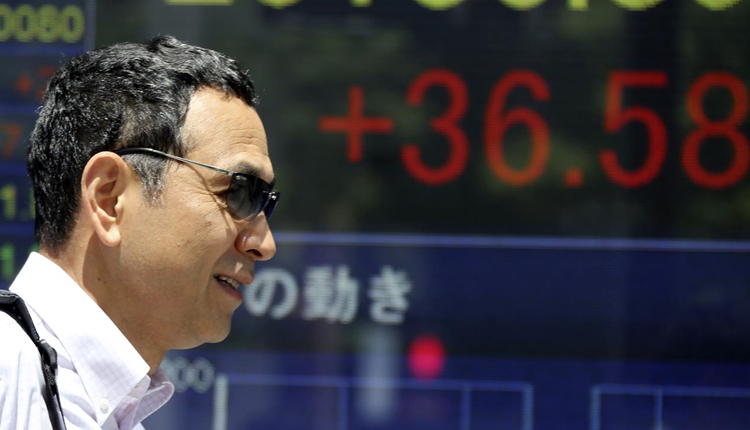Asian markets fell sharply on Thursday morning, with the stock indexes in Shanghai, Shenzhen and Tokyo all tumbling more than 4 percent.
In the Greater China region, the Hang Seng index was down by 3.84 percent in late morning trade. Over on the mainland, the Shanghai composite and the Shenzhen composite both opened the day with declines exceeding 3 percent.
The Shanghai index traded lower by 4.34 percent and Shenzhen was down about 5.52 percent.
In Taiwan, the Taiex dropped by 6.28 percent, with lens maker and Apple supplier Largan Precision plunging 9.89 percent.
In Sydney, the ASX 200 fell 2.43 percent, with most sectors trading lower. The energy subindex was down 3.62 percent, materials was lower by 2.48 percent and the heavily weighted financial sector fell 2.38 percent.
Major banking names in Australia fell, with Commonwealth Bank shares down 2.32 percent. Mining stocks were also lower, with Rio Tinto down 2.94 percent and BHP off by around 3.4 percent.
Japan’s markets also continued to falter in the afternoon. The Nikkei 225 dropped by 4.36 percent while the Topix index declined by 3.88 percent, with major sectors trending down.
Over in South Korea, the Kospi continued the general trend for the day by tumbling 3.6 percent.
Southeast Asia isn’t immune from sell-off
In Southeast Asia, stocks also fell sharply. Singapore’s Straits Times Index fell by 2.75 percent, while the Jakarta composite was down by 1.7 percent, and the KLCI in Malaysia was lower by 2.49 percent.
Meanwhile, India’s Nifty 50 fell by around 2.9 percent.
Overnight on Wall Street, the Dow Jones Industrial Average dropped by 831.83 points to 25,598.74, the Nasdaq Composite fell 4 percent to 7,422.05. The S&P 500 dropped 3.3 percent to 2,785.68.
Both the Dow and S&P 500 posted their biggest one-day drops since early February, while the Nasdaq notched its largest single day sell-off since June 24, 2016.
At the same time, the most widely watched measure of investor fear spiked on Wednesday. The CBOE Volatility Index, popularly known as the VIX, leaped about 44 percent to 22.96 — its highest level since the beginning of April. The VIX measures implied volatility on S&P 500 index options.
Cryptocurrencies drop along with stocks
Meanwhile, the price of major cryptocurrencies plunged on Thursday with nearly $13 billion of value being wiped out in a matter of hours.
At mid-morning, bitcoin had fallen nearly 5 percent to $6,303, while XRP and ethereum both tanked by more than 10 percent, according to data from Coinmarketcap.com. It’s not unusual to see bitcoin lead other digital tokens lower.
In just three hours, nearly $13 billion of value had been erased from the entire cryptocurrency market.
US futures dropping steeply
U.S. futures continued to trend lower on Thursday morning during Asian hours. The Dow Jones industrial average futures pointed to an implied open of 347.74 points lower.
Some analysts said that the decline on Wall Street did not appear to have any catalyst, including the ongoing trade friction between the U.S. and China. That has “been ongoing since the start of the year,” Joseph Capurso, senior currency strategist at the Commonwealth Bank of Australia, wrote in a note.
Ray Attrill, head of foreign exchange strategy at National Australia Bank said in a note that this month’s sell-off in stocks could have been due to “a simple rush to book some profits.”
“The smaller-cap Russell 2000, representing companies that should not be particularly sensitive to either US bond yields or trade concerns, started falling well ahead of the US household name indices, and month-to-date is now off almost 10%,” Attrill said.
Meanwhile, U.S. President Donald Trump took aim at the Federal Reserve on Wednesday for continuing to raise interest rates despite some recent market turbulence.
“I think the Fed is making a mistake. They are so tight. I think the Fed has gone crazy,” the president said after walking off Air Force One in Erie, Pennsylvania for a rally.
Commenting on the sell-off on Wall Street, Trump said: “It’s a correction we’ve been waiting for for a long time, but I really disagree with what the Fed is doing.”
Currencies and oil
The U.S. dollar index, which tracks the greenback against a basket of its peers, traded at 95.225.
At the same time, the Japanese yen, generally considered a safe-haven currency for fearful investors, was at 112.14 against the dollar. The Australian dollar was at $0.7077.
In the oil markets, prices continued to fall in the morning of Asian trade. The global benchmark Brent crude futures contract was down by 1.9 percent at $81.51 per barrel, while the U.S. crude futures contract slipped by 1.68 percent to $71.94 per barrel.
Source: CNBC




